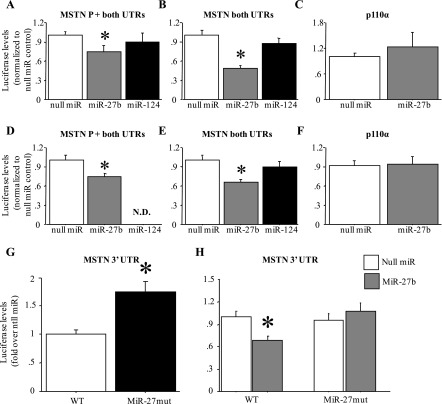Fig. 6.
MiR-27b decreases activity of a mouse MSTN 3′-UTR-luciferase reporter construct in vitro. A and D: activity of a plasmid containing the mouse MSTN 1,200-bp promoter, 5′-UTR, and 3′-UTR. B and E: a plasmid containing a minimal MSTN promoter (20 bp upstream of the TATA box), 5′-UTR, and 3′-UTR. C and F: a plasmid containing the SV40 promoter and the p110α 3′-UTR. A–C: results for C2C12 myoblasts. D–F: results for C2C12 myotubes. All results were normalized to the null miR-cotransfected control. In each panel is shown the results of cotransfection with the null miR control, miR-27b, or miR-124. ND, no data. Cotransfection with miR-27b significantly attenuated activity of the MSTN but not p110α constructs, and miR-124 had no effect. Bars in all panels represent means ± SE for n = 3 different experiments with 6 wells per experiment. *Significantly different from null miR cotransfected, P < 0.05. G: effect of mutation of the miR-27 site of the mouse MSTN 3′-UTR on basal activity in C2C12 myotubes. Mutation of the miR-27 recognition sequence significantly increased activity relative to the wild-type (WT) construct. Bars represent means ± SE for n = 3 different experiments with 6 wells per experiment. *Significantly different from wild-type construct, P < 0.05. H: effects of mutation of the miR-27 site of the mouse MSTN 3′-UTR on miR-27b responsiveness. Mutation of the miR-27 recognition sequence abolished responsiveness to miR-27b cotransfection compared with the wild-type construct. Bars represent means ± SE for n = 3 different experiments with 6 wells per experiment. *Significantly different from wild-type construct cotransfected with null miR, P < 0.05.

